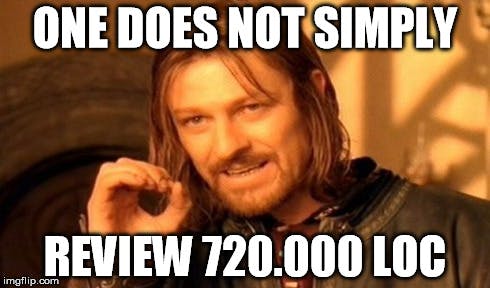- Published on Friday, November 5, 2021, last updated
How to review code in GitHub
Learning how to do a code review is crucial for maintaining high development standards and mastering code review on GitHub is crucial for your team. With You can integrate changes smoothly, track updates in real time, and enhance cross-team visibility. If you’re unsure how to do code review in GitHub, following clear code review guidelines will help establish a repeatable process as we will see later on.
Effective GitHub code reviews create a transparent feedback loop, uphold coding standards, and support timely merges. So stay with us and learn how you can improve your team's workflow.
Table of Contents
GitHub code review best practices
Code review is one of the most important practices engineers should have. Your code will always need to be reviewed, and you will always need to review your coworkers' code. If you approach code reviews as a learning process, everyone wins when you understand how to do a code review effectively.
Why is code review important?
Perfect for ensuring best practices and educating other developers
Code reviews are one point of contact between engineers during the development process. They are the perfect time to ensure that the team is in sync regarding standards, GitHub code review best practices, and code style.
When done properly, the team will advocate for best practices and share knowledge to raise the average level of the engineering squad. That way, junior developers will be able to quickly learn and reach the maximum of their potential with peer feedback.
Mandatory to find defects and opportunities for improvement
Code review ensures that:
- the test code is robust and valid,
- the design and implementation are consistent across the application.
Learning how to do a code review correctly also highlights opportunities for improvement. They are not about finding bugs, that's what tests are for.
Principles of a good code review
If you still wonder how to do code review in GitHub, stay with us and we will guide you through the process.
What is not written, does not exist
As Google says, “technical facts and data overrule opinions and personal preferences.” (Google principles for code reviews). As a reviewer, if you request changes on the current implementation, provide resources and explain the benefit of your solution with specific pieces of knowledge.
If no resources are found about a specific topic, reach approval and create some documentation for the next time this conflict appears.
Keep the team spirit and be kind
You are reviewing a teammate or are being reviewed by one. The goal of a code review is to share knowledge, not to hurt the ego. If you are reviewing or responding, think before sending a derogatory comment.
Implement a code review process or ask for a review
Most productive engineering teams have a detailed process for code reviews. In this document, explain who you should be asking for a review (is it in a squad? depending on the updated code?), how many approvals you need (generally from one to three), how to create tests before a code review, and which checks are mandatory to pass before merging the pull request.
If your team has not yet a detailed process, it is ok to ask for a review. Ping the people you think should review your code, do not wait for someone to find it by themselves.
Review daily and sessions should last less than one hour
Doing code review on GitHub should be a daily habit. As our focus decreases over time, it is best to review code by short sessions and often.
Understand what you're reviewing first
You won't be able to provide an effective code review if you do not understand what you're looking at.
Having a brief checklist before looking at the code is a great way to be sure that you fully understand and that the code is ready to be reviewed. Inspired by Hugo Dias in his code review article, here is a code review template checklist that we advise you to customize and follow:
- Does the PR have enough tests to cover the update?
- Does this change require integration tests?
- Is documentation necessary? If yes, is the new documentation (readme, wiki page, or external documentation) online/ready to be online?
- Are the product requirements standards met?
- Does this change updates any library or dependency that may break the system?
- Is there any extra task the developer needs to do after merging this code?
- Should someone else review the PR before my review? (ex: security team to validate the changes)
If an item is checked, you should ask for more information before digging into the code.
Test the code before looking at it
You don't want to be the reviewer that approved a pull request where the code is not working. Approving without testing is hazardous. No matter the number of lines changed, you should test the code.
Code review should be fast
According to Google code review guidelines about speed, a slow code review process has three negative consequences.
- The product development process slows down. Not reviewing someone's code might fasten your work, but you're slowing down the rest of the team.
- The team starts to protest the code review process. Waiting days for someone to review a few lines of code is frustrating, especially if the review ends by requesting substantial changes.
- Code health is deteriorating. It's easier to accept refactoring or cleanups when you are not yet working on another issue. Fast code reviews raise the code health level.
If you receive a code review notification and are not working on a focused task, try to review the code as soon as possible. If you did not have the time in your day to review the code, do it first thing the next morning.
One pull request should focus on only one task
Separating large task into small pull requests help the team gain in velocity for two reasons:
- Small pull requests are easier to review, so reviewed faster.
- Small changes to the codebase are easier to dive into and understand. So code reviews are more effective.
The team behind Accelerate: The Science Behind Devops noticed that most efficient engineering teams were working on independent and short-lived branches. That way, every engineer focuses on only one subject at a time, and code reviews are more manageable.
Furthermore, in Best Practices for Peer Code Review, SmartBear conducted a study and found out that developers should not review more than 400 lines of codes at a time. Beyond 400 lines, the ability to identify defects diminishes as our brain can not process so much information.
So next time your pull request has more than 400 lines changed, try to separate it into two different pull requests! The best practice is to open stacked pull requests. They are feature branches that are checked out from other feature branches to build small and coherent units to represent changes.
Annotate your pull request and code before the review
Adding context is particularly helpful in GitHub code reviews, so reviewers understand tricky parts quickly. If the author of the pull request wrote some comments on the code in tricky parts, it will help the reviewers and prevent some avoidable questions to be asked.
Provide screenshots, write comments and help your reviewer better understand your work before requesting a review.
Use a pull request template (with a checklist)
A good pull request template doubles as a code review template will help you better prepare for the review. They are useful to avoid common mistakes, provide clear expectations on what should be ready when requesting a review, and avoid useless back-and-forth during the code review. A checklist inside your pull request template is usually the easiest way to prepare your pull request. You should update your template along the way to customize it to your needs.
These different principles form the core of GitHub code review best practices for any team. You can learn more about .
Is styling important?
If styling is important for your team, you should create a style guide to do code review on GitHub. As we said in our first point, what is not written does not exist. Develop your style guide with the approval of the whole team and what is not inside it, will be a matter of personal preferences.
A code review guideline is a set of rules for submitting and reviewing code changes in a project. It outlines the steps for creating a pull request, submitting it for review, and merging it into the codebase.
It's important because it establishes a clear and consistent process for collaborating. It can improve code quality, reduce review time, and ensure a smoother development process. Teams, developers, and managers can all benefit from a defined guideline.

1. Establish clear goals and objectives for the code review process.
Clear goals and objectives for the code review process are important to ensure that the review process aligns with the project's goals and focuses on the most important aspects of the code. To implement this guideline, stakeholders should:
1. Define the goals and objectives of the code review process.
2. Communicate them to team members.
3. Regularly review and evaluate them to ensure relevance.
Once you have done the preparation work, you will have your first guideline in place. I'm adding an example to help you start:
Goals:
- To ensure that the code meets the project's functional and non-functional requirements
- To identify and correct defects in the code
- To improve the overall quality of the codebase
- To provide a mechanism for sharing knowledge and best practices among team members
Objectives:
- To review all code changes before they are merged into the main codebase
- To provide constructive feedback to developers to improve the quality of the code
- To ensure that the code is consistent with the coding standards and guidelines
- To ensure that the code is well-documented and easy to understand
- To identify and correct defects in the code
- To ensure that the code is scalable, maintainable, and extensible
- To identify and share best practices and knowledge among team members

Thank you Tommy! We're now all aligned.
2. Clearly define the roles and responsibilities of each team member involved in the review process.
Clear roles and responsibilities for each team member involved in the review process are important to ensure efficiency and prevent confusion.
You don't want people that have nothing to do with a specific pull request reviewing it. This will only slow down the process, waste time and create frustration.
Roles and Responsibilities:
- Author: The developer who submits the code for review
- Reviewer: The team member who reviews the code and provides feedback. How should we assign the reviewer?
- Lead Reviewer: The team member responsible for coordinating and overseeing the code review process
- Approver: The team member who approves or rejects the code changes after the review process
3. Set guidelines for the scope and focus of the code review, including the size of pull requests and the areas of code to be reviewed.
Here are some steps to define the scope and focus of the code review:
1. Define the scope and focus of the code review.
2. Set guidelines for the size of pull requests.
3. Establish criteria for evaluating code.
4. Communicate the guidelines clearly to team members.
Guidelines for the Scope and Focus of Code Review:
- Define the scope of code review: Which files and areas of the code should be reviewed?
- Define the focus of code review: Which aspects of the code should be prioritized for review (e.g., functionality, performance, security)?
- Set guidelines for the size of pull requests: What is the maximum size of a pull request that can be reviewed effectively?
- Establish criteria for evaluating code: What criteria should be used to determine whether the code meets the project's standards and requirements?
- Communicate the guidelines clearly to team members: How should team members be informed of the guidelines, and how should they be enforced?

The guideline says that you shouldn't ask for changes here!
4. Define standards for code formatting, commenting, and documentation.
Defining standards for code formatting and code review, in general, is hard. I tried to summarize the main steps to it easily:
1. Identify the coding standards to follow.
2. Define guidelines for commenting.
3. Set documentation requirements.
4. Determine the tools to be used.
5. Communicate the guidelines.
Standards for Code Formatting, Commenting, and Documentation:
- Identify the coding standards to follow: Which coding standards should be used, such as indentation, line spacing, and naming conventions? How many lines max per pull request (you should not [review more than 400 lines to reduce pickup time](https://axolo.co/blog/p/how-to-reduce-cycle-time))
- Define guidelines for commenting: What types of comments should be used, and where should they be placed in the code? How should comments be formatted?
- Set documentation requirements: What types of documentation are required, such as high-level design documents, API documentation, or user manuals? What is the expected level of detail?
- Determine the tools to be used: What tools will be used to ensure that code formatting, commenting, and documentation standards are enforced?
- Communicate the guidelines: How should team members be informed of the guidelines, and how should they be enforced?

5. Determine the frequency and timing of code reviews, and ensure they are integrated into the development process.
The two most important things for this part are the frequency and timing of code reviews. I have written an article specifically on , so I will just summarize the main steps below.
Don't forget that code reviews should be fast, daily, and well-tested. So for this part, you should:
Frequency and Timing of Code Reviews:
- Define the frequency of code reviews: How often should code reviews be conducted (e.g., daily, weekly, or monthly)? How long should they last?
- Determine the timing of code reviews: At what point in the development process should code reviews be conducted (e.g., before merging, after merging, or during testing)?
- Ensure integration into the development process: How should code reviews be integrated into the development process, and how should they be prioritized alongside other tasks?
1. Define the frequency of code reviews
2. Determine the timing of code reviews
If you want to make sure your code reviews are quick and efficient, I recommend you to read this article:
6. Encourage a positive and constructive culture around code reviews, emphasizing the importance of collaboration and learning.
1. Emphasize the importance of learning.
Encourage team members to view code reviews as an opportunity for learning and improvement, rather than a critique of their work.
2. Foster a collaborative environment.
Encourage team members to work together to identify issues and propose solutions. You should especially focus on that if your team is mostly working remotely.
3. Recognize achievements and contributions.
Acknowledge team members who have made significant contributions to the review process, and recognize those who have demonstrated a positive and constructive attitude towards feedback. This is your time to motivate the team and shine as a manager!
4. Regularly review and refine the culture around code reviews.
This will help ensure that the culture remains positive, constructive, and aligned with the goals of the project. Be sure that your team knows that it is heard. If you're interested in building the best work environment for your developer, you should also check out our advice for a .
That's it! Now I hope you know how to create your code review guideline, if you're interested in a markdown template, I have summarized everything in .
Bringing It All Together: Succeeding with GitHub Code Reviews
By adopting consistent code review guidelines and a clear code review template, you can streamline feedback, maintain high-quality merges, and keep your team aligned. Make reviews an integral part of daily work, and leverage automation to ensure timely, focused pull requests.
Embracing thorough code review guidelines ultimately refines your team’s approach, ensuring higher code quality and smoother deployments. From leveraging a code review template for consistent formatting to conducting code review on GitHub with well-defined roles, each step fosters continuous improvement. By staying aligned and regularly engaged, you can spot errors early, expedite feedback loops, and maintain a maintainable codebase. Whether you’re new to code reviews in GitHub or a seasoned engineer, a solid framework for collaboration ensures each contribution is valuable and efficient.